Dry Rot
As Ontario and Quebec’s trusted mold removal professionals, we are receiving an increasing amount of requests from homeowners in the Montreal, Gatineau and Ottawa areas regarding dry rot.
The concerns of our clients are legitimate. Dry rot, also called cubic or fibrous rot, is one of the last things you want to find in your home. More than any other fungus, dry rot has an unparalleled ability to destroy wood, eating away at building structures much faster than any other mold.
Since the fungus can grow quickly (often hidden from plain sight), it is important for homeowners to be aware of the proper steps to take in order to detect, eliminate and prevent dry rot in their homes. It is also important for homeowners to understand when they should call remediation professionals.
Here is everything you need to know about dry rot. If you have any questions, do not hesitate to contact us and discuss your concerns with one of our experts.
Worried About Dry Rot? Get a Free Inspection!
Dry rot can severely damage your home’s structure and is often difficult to detect. Don’t let it go unchecked! Contact Mold Busters for a free virtual mold inspection. Our experts are ready to provide you with a comprehensive assessment and a plan to tackle any mold issue, ensuring your home is safe and healthy. Act now to protect your space!
What is dry rot?
Dry rot is a common synonym for wood decay, but the term actually refers to a wide variety of fungi, all of which share a common characteristic–their love of wood. They feed off of the cellulose and humidity found in wood until it decays.
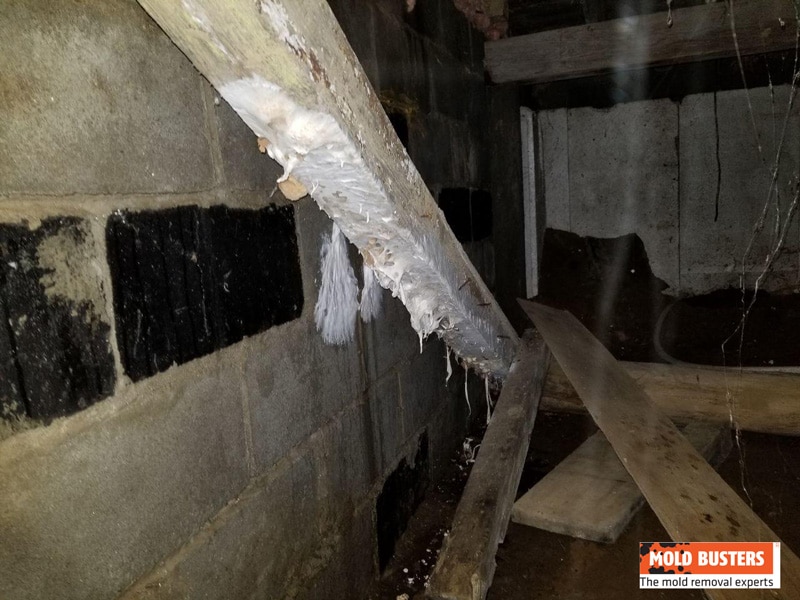
The appearance of these fungi varies. Most of them, however, are orange, brown or yellow, and are accompanied by grey mycelia that can extend several metres.
Two main species of dry rot are most often found in buildings: Meruliporia incrassata and Serpula lacrymans. In America, the first tends to develop on the Pacific coast, while the second is more common in the temperate climates of the East. It therefore directly affects Ontario and Quebec’s homeowners. Unfortunately, this type of dry rot is also the most destructive.
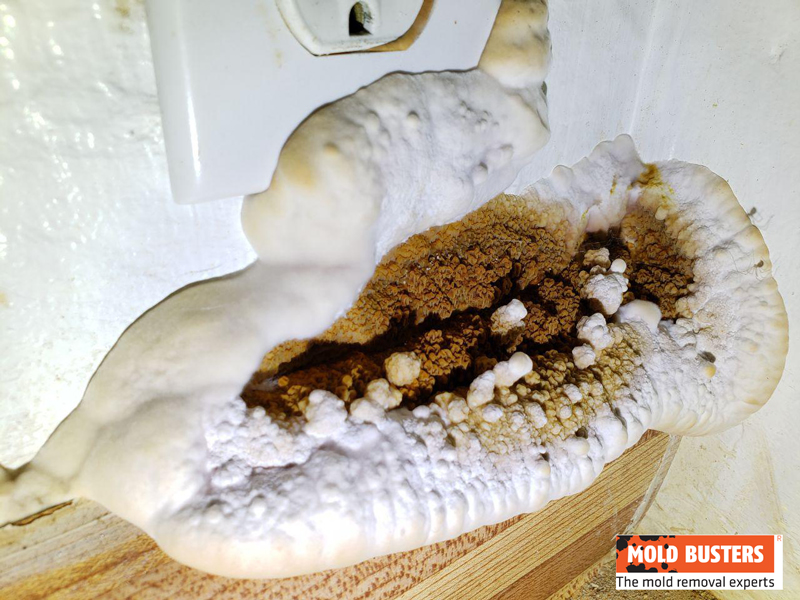
Like all fungi and mold, dry rot needs moisture to grow, which makes its name somewhat misleading. However, it has the special ability to drain this water far away from the area that it has colonized, thanks to its mycelium, which can be more than 5 metres long and extend over non-organic surfaces like ceramic tile and concrete. Dry rot can thus contaminate and destroy even dry wood, hence its name.
Dry rot pictures
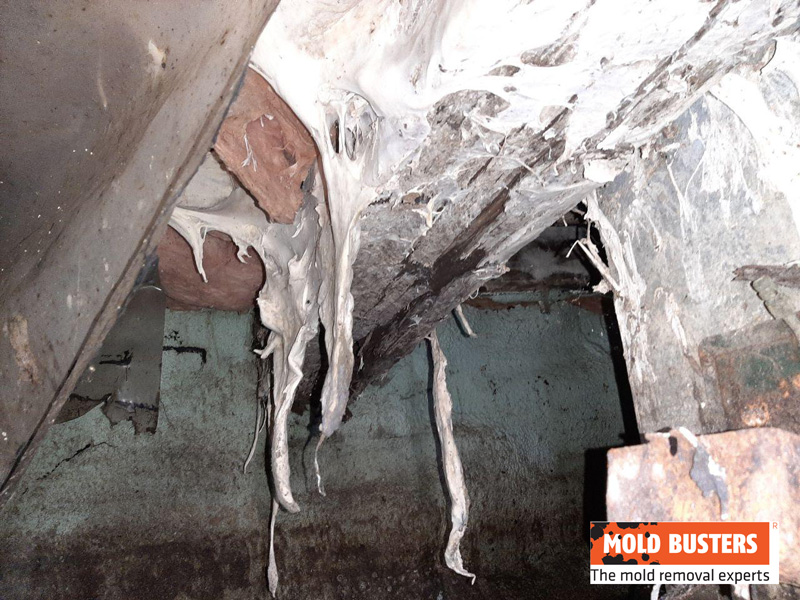
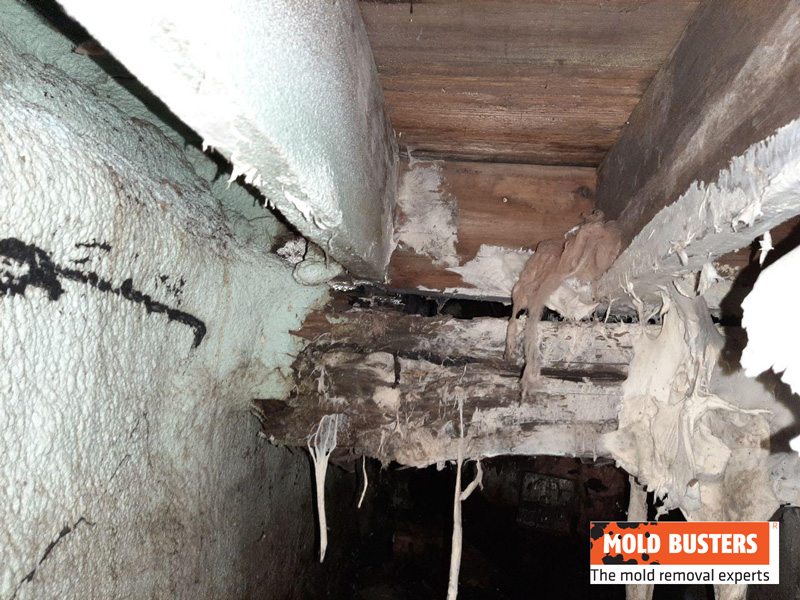
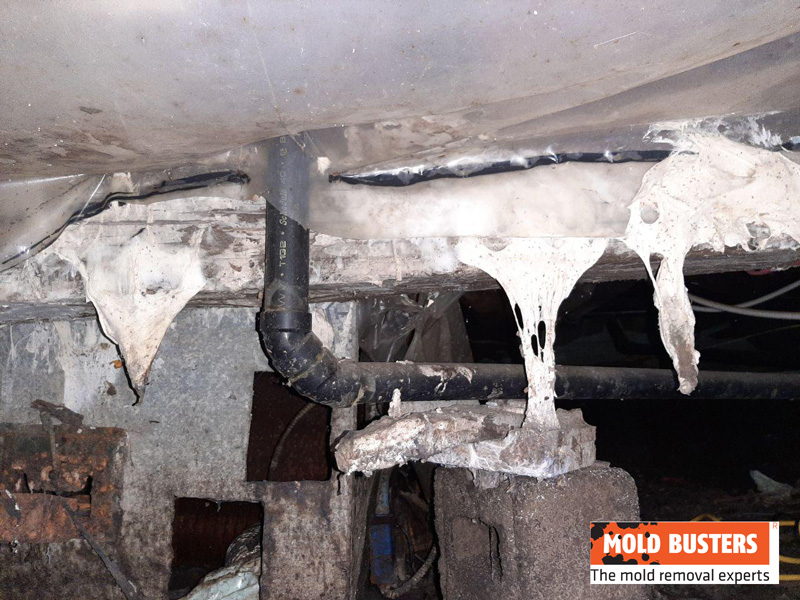
What causes dry rot in homes?
Three environmental conditions need to be met in order for dry rot to start growing:
- The right temperature
- Moisture
- Organic material (i.e. wood)
Certain characteristics of dry rot, however, make it a much bigger threat than other molds. For example, it seems to have adapted specifically for growth indoors since it multiplies best between 3°C and 26°C, with 20°C being its optimal temperature. Anything above 30°C will stop the growth of dry rot, and 50°C or more, especially over extended periods of time (12 hours or more), will kill the fungus.
As for moisture, dry rot requires a damp or wet surface on which its spores can settle and begin colonization. However, its ability to reach moisture using its mycelia allows dry rot to continue growing on the area it has contaminated even once it has dried.
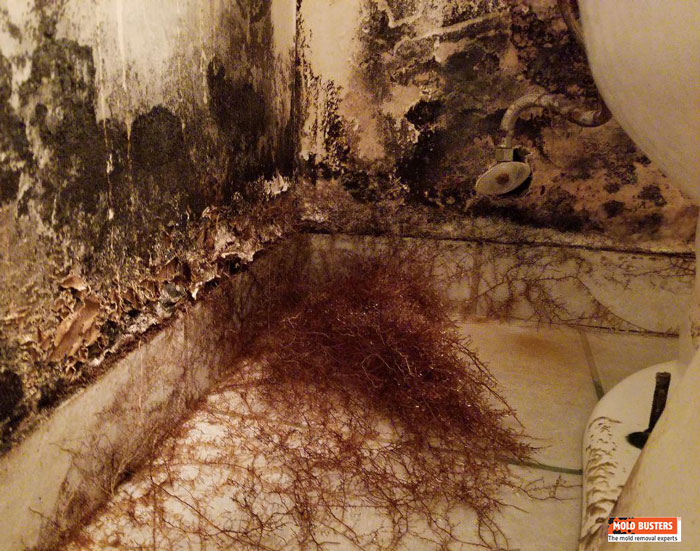
Finally, when it comes to food, dry rot attacks only wood. It is therefore very rare to find it on other materials, however, it will attack almost all species of wood, with a preference for conifers (although hardwoods are not spared).
Once settled on the wood, dry rot will then target cellulose, ultimately leading to rot. The contaminated wood is then irreversibly affected. A loss of 1% of its weight can cause it to lose up to 50% of its strength.
Where to look for dry rot in the house?
In a home, the three conditions necessary for the development of dry rot are easily met. Furthermore, poor ventilation and stale air can increase humidity and keep fungal spores inside. Moisture intrusion resulting from condensation, leaks or flooding can provide the large quantities of water necessary for fungal growth.
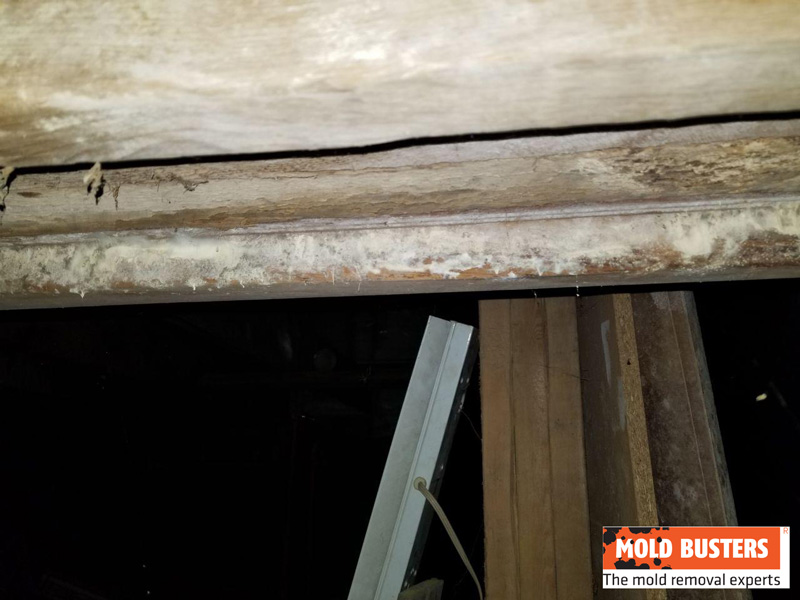
Dry rot is, therefore, most common in basements or attics, which are often poorly ventilated, prone to moisture problems and contain lots of exposed wood (beams, joists, etc.) that serves as food for dry rot. That being said, dry rot is capable of growing in almost any room given it has the right temperature, moisture and a source of nutrients.

Did you know?
Only 8% of basements we have tested didn’t have presence of mold?! Find out more exciting mold stats and facts inside our mold statistics page.
What kind of damage can dry rot cause?
When it comes to dry rot, any and all wood in your home is at risk. Key structural elements, such as beams or framing, can be severely compromised in a relatively short period of time.
By eating away at the cellulose in wood, the dry rot decreases the strength of the wood and compromises the structural integrity of the home.
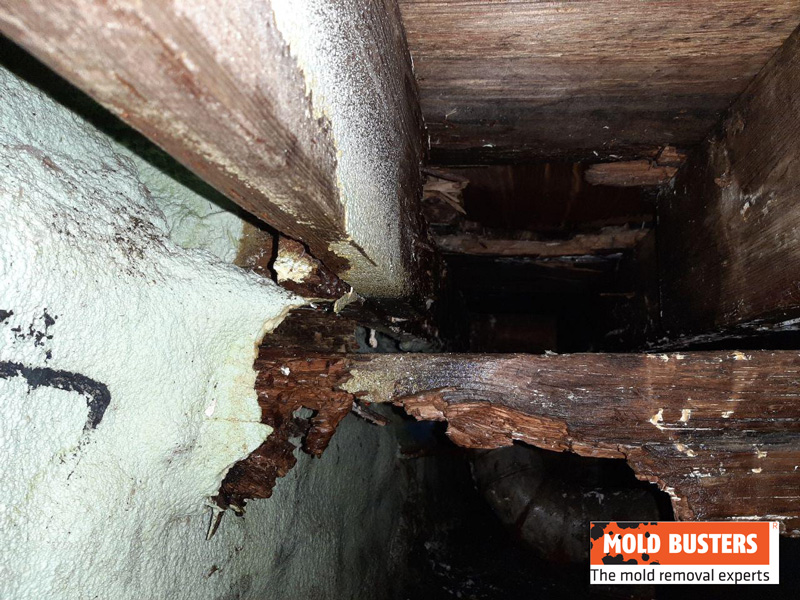
It is therefore very easy to imagine the disastrous consequences that fungi like Serpula lacrymans can have on a building. The entire structure of a house, from its floors to its roof, can be affected or even completely destroyed.
If swift remedial action is not taken, the physical damage can put a tremendous strain on homeowners, especially financially. Serious cases may even run into the tens of thousands of dollars in expenses in order to replace the entire framework and to decontaminate the property to get rid of fungal spores.
How to prevent dry rot?
Protect your home against dry rot
As the saying goes, prevention is better than the cure. And it just so happens that dry rot can be prevented by following these simple steps.
Because dry rot needs water in order to multiply, your main goal should be to prevent moisture from building up in your home. Repair any leaks as soon as possible. If you experience water damage, react promptly to repair any affected materials. Thoroughly dry all affected objects, and replace any materials that were damaged beyond repair.
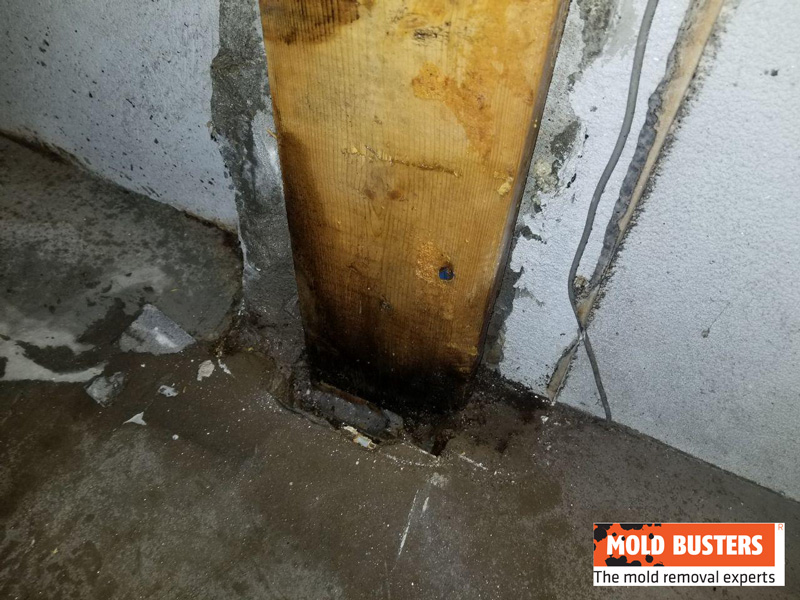
In some cases, however, moisture is inevitable. Certain regions, for example, are naturally more humid than others and thus result in higher humidity inside the home. In other cases, the soil surrounding the foundation will have a high water content, which may result in water seeping into the basement.
The remedial action you take will therefore depend on the situation. You may need to install a dehumidifer to reduce the humidity in your home, or you may need to repair cracked foundation if you’re constantly experiencing leaks in your basement.
In addition, it is crucial to have healthy indoor air quality to ensure adequate ventilation throughout the entire house. Stale air tends to hold more moisture so you can drastically reduce your chances of dry rot and mold if you ventilate your house.
Once again, the basement and attic are particularly problematic areas when it comes to ventilation. Since we don’t spend too much time in these rooms, we often neglect their ventilation. If these two rooms are not properly equipped, you should invest in an efficient HVAC system, since the large amounts of wood in these spaces makes them prime targets for dry rot.
Finally, if you are planning to build a house, some design choices may help protect you from Serpula Lacrymans and other molds. Proper soil grading and good drainage of rainwater around your home will decrease the chances of moisture penetrating your home. Choose your wood wisely during construction: its moisture content should not exceed 19%.
Regularly inspect your property
Regularly checking your home for signs of dry rot is a great way to identify problems early on, before they have a chance to lead to significant structural damage.
So what do you look for? Dry rot can vary in size but typically it will be circular in shape with a velvety texture and colour ranging from yellow to brown. It is usually found on wood, even pieces that have been protected by varnish, paint or other coating.
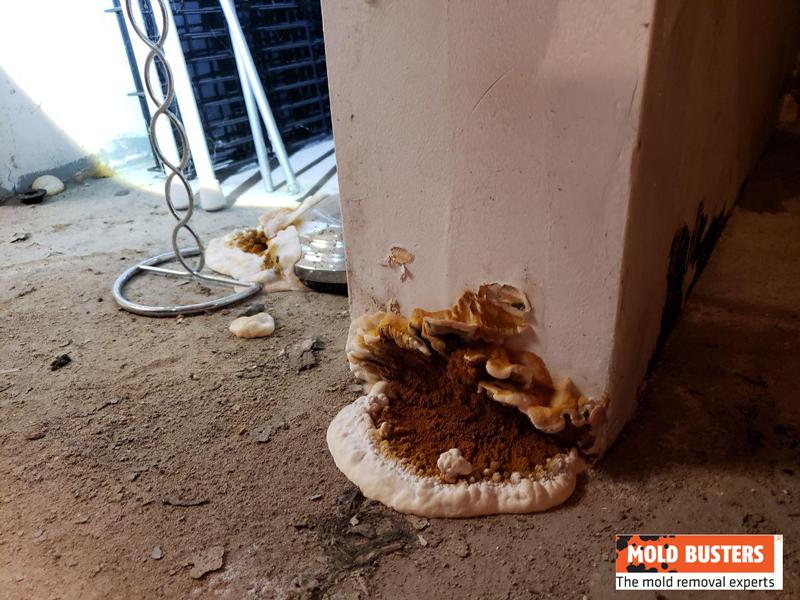
It is not uncommon for dry rot to grow out of sight; for example, behind walls or in your attic. In these cases, look for these signs that may hint at its presence:
- Wood that’s crumbling or falling apart,
- The presence of mycelium (white or grey thread-like structures that resemble plant roots), even on inorganic materials
- Stains or discoloration that may represent water damage or moisture intrusion
- Bubbling paint or wallpaper
Sometimes dry rot can be confused with other problems within a building. For instance, not all yellow fungi are Serpula lacrymans, which is why it may be necessary to perform a mold test to confirm. If in doubt, contact an expert who can perform a thorough inspection of your property and take any necessary mold tests.
Mold Busters offers our Montreal, Gatineau and Ottawa customers comprehensive mold inspection services that can uncover even hidden mold problems that could be contributing to the destruction of your home and your health. We use the latest technologies, such as our high-resolution infrared cameras, particle scanners and air sampling pumps, to detect issues without causing physical damage to your home. Contact us today to make an appointment.
How to treat dry rot?
If you have officially identified dry rot in your home, it’s important to eliminate it as soon as possible. If a large surface is affected, it is recommended to leave the remediation to professionals. Because dry rot affects the structural safety and integrity of your property, the slightest mistake could result in physical damage to you, your home, not to mention your wallet. In addition, given the extent of most dry rot infestations, it is typically not recommended to treat it with traditional cleaning products, such as bleach.
Not to worry though. There are many other ways to get rid of dry rot, depending on the size of your problem.
Specially engineered anti-fungal cleaners can eliminate small contaminations. Similarly, a heat treatment can be applied to contaminated areas that are limited in size, as long as the dry rot has not penetrated deep inside the wood. In more severe cases, however, the only possible solution may be to completely remove contaminated materials and replace them with new, healthy materials. This applies both to the wood and to any masonry elements that may have been affected by the dry rot. To prevent cross-contamination during the dry rot removal process, the work must be carried out in a contained space–another reason why getting professional help is a must.
At Mold Busters, we are trained and experienced in such situations. If the problem is taken care of early enough, decontamination can be carried out without causing too much damage to your home, which will also drastically reduce your costs. Contact us today to get an estimate or a scope-of-work assessment.
Checkout our real case dry rot remediation work in residential building by comparing the before and after photos:

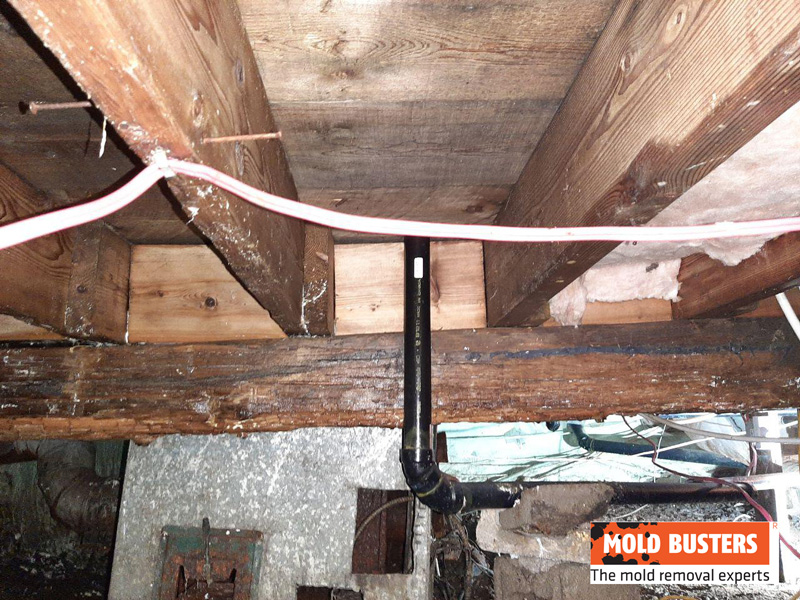
Dry rot in Quebec: Financial aid for dry rot removal
Unfortunately, awareness about dry rot is still in its initial wwws. However, the subject is becoming an increasingly bigger topic of conversation in Quebec, as cases of dry rot are on the rise.
In this regard, the Quebec government has begun to take action. The problem, though, is that there is still very little data and scientific research done on dry rot and its effect on Quebec properties.
In October 2018, the Quebec Housing Corporation (SHQ) launched its residential intervention plan for dry rot. Its goal is to help finance decontamination work in exchange for collecting information on the fungus. Five million dollars over a three-year period have been allocated for this program.
Who is eligible?
The funding is intended for owners of a Quebec property that live in the home as their principal residence. The home should be equipped with an independent sanitary installation or running water. Tenants, non-occupying homeowners, and businesses are therefore not eligible.
Single-family homes, duplexes, triplexes, townhomes, and in some cases mobile homes are eligible for the funding. A building that includes both residential and commercial spaces is eligible for the program if it includes a dwelling that is the principal residence of its owner.
It should be noted that buildings that have received financial assistance under a program of the Department of Public Safety over the past five years are excluded from the program.
How it works
Are you eligible for the program?
Before any work can be done, you must send an application form to SHQ (available on their website, only in French. To get the form, look for the .pdf file “Demande de participation”). If your file is accepted, SHQ will declare you eligible.
Contact an indoor environmental specialist who meets the certification criteria of the SHQ. This professional will be responsible for collecting samples from your home and analyzing them to confirm the presence of dry rot fungi. Once the contamination has been formally proven, SHQ will approve your file.
The indoor environmental specialist will then write an assessment report detailing the extent of the damage, which will then be sent to a building specialist to draw up a technical estimate, detailing the work to be carried out to remediate the property.
Using this estimate, you must obtain a quote from at least two specialized contractors. Once the contractor has been chosen, SHQ will issue a certificate of eligibility.
At this point, remediation and decontamination work may begin. Invoices must be forwarded to SHQ, which will make payments on the basis of scheduled reimbursements and the certificate of eligibility.
Once the work is complete, final payments can be made by SHQ before the file is closed.
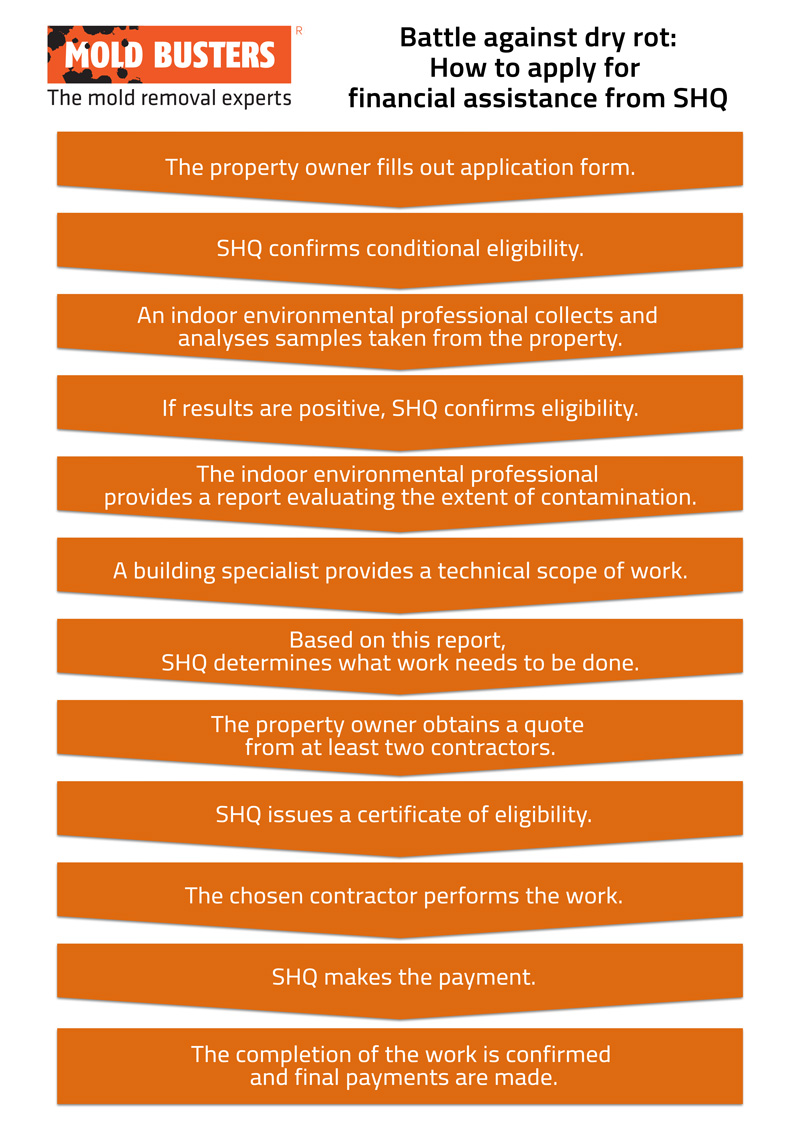
What help is provided?
The procedure may seem complex at first glance, but the help provided can be invaluable, literally. The subsidy granted by SHQ covers 75% of the recognized cost of the work, up to $75,000 when the losses in your building are partial, and up to $100,000 per eligible building in the case of a demolition and reconstruction (for a total loss).
Moreover, the Société d’habitation du Québec will fully cover expenses related to the contamination assessment report, the technical specifications (scope of work) and any professional fees in case additional expertise was required.
To find out more, visit the SHQ website. Our indoor environmental professionals are also at your disposal if you need more information about dry rot removal.

Get Special Gift: Industry-Standard Mold Removal Guidelines
Download the industry-standard guidelines that Mold Busters use in their own mold removal services, including news, tips and special offers:
Published: September 16, 2019 Updated: June 24, 2024

Written by:
John Ward
Account Executive
Mold Busters
Fact checked by:
Michael Golubev
CEO
Mold Busters
